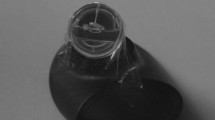Abstract
The excimer laser-ArF has certain characteristics that render it ideal for the performance of stapedotomy. These include the short wavelength of the emitted laser beam (193 nm), its high water absorption rate, the ability of pin-point focusing and its capability of operating in a pulse mode.
In an effort to measure the temperature changes of the labyrinthine fluids in the inner ear during excimer laser irradiation, a cochlear model with the dimensions of the normal vestibule was designed. In this model cerebrospinal fluid (CSF) was used as a substitute for the labyrinthine fluids.
Our study showed that the number of pulses needed to created the stapedotomy fenestra to the bony plate were 112–132. The temperature elevation of the CSF during laser irradiation showed only a slight increase of 0.1–0.4°C.
The results of this study are very encouraging for the future use of the excimer laser in clinical situations.
Similar content being viewed by others
References
McGee MT. Laser in Otology. Otology—Current Concepts and Technology.Otolaryngol Clin North Am 1989,22:233–8.
Sataloff J. Experimental use of the laser in otosclerotic stapes.Arch Otolaryngol 1967,85:58–60
Wilpizeski C. Experimental carbon dioxide laser surgery of the ear. A caveat based on primate subjects and cadaver temporal bones. In: Kaplan I (ed)Laser Surgery. Jerusalem: Jerusalem Academic Press, 1978:91–103.
DiBartolomeo JR. The Argon and CO2 laser in otolaryngology: Which one, when and why?Laryngoscope 1981,91 (Suppl 26):1–16.
Vollrath M, Schreiner C. The effects of the Argon laser on temperature within the cochlea.Acta Otolaryngol (Stockh) 1982,93:341–8.
Gantz BJ, Kishimoto S, Jenkins HA, Fisch U. Argon laser stapedotomy.Ann Otol Rhinol Laryngol 1982.91:25–6.
Gardner G, Robertson JH, Tomoda K, Clark CW. CO2 laser stapedotomy: Is it practical?Am J Otolaryngol 1984,5:108–17.
Segas J, Georgiadis A, Christodoulou P et al. Use of the excimer laser in stapes surgery and ossiculoplasty of middle ear ossicles: preliminary report of an experimental approach.Laryngoscope 1991,101:186–91.
Perkins RC. Laser stapedotomy for otosclerosis.Laryngoscope 1980,90:228–41.
DiBartolomeo JR, Ellis M. The Argon laser in otology.Laryngoscope 1980,90:1786–96.
McGee TM. The Argon laser in surgery for chronic ear disease and otosclerosis.Laryngoscope 1983,93:1177–82.
Lesinski SG. Lasers for otosclerosis.Laryngoscope 1989,99(Suppl 46):1–24.
Silverstein H, Rosenberg S, Jones R. Small-fenestra stapedotomies with and without KTP laser: a comparison.Laryngoscope 1989,99: 485–8.
Bartels LJ. KTP laser stapedotomy: Is it safe?Otolaryngol Head Neck Surg 1990,103:685–92.
Hodgson RS, Wilson DF. Argon laser stapedotomy.Laryngoscope 1991,101:230–3.
Anson BJ, Donaldson JA (eds). The internal ear. In:Surgical Anatomy of the Temporal Bone, 3rd edn. Philadelphia: WB Saunders Co, 1981:296–312
Gacek RR. The vestibular system. In: English GM (ed)Otolaryngology, Philadelphia: JB Lippincott Co, 1989, Chap 8:1–21
Srinivasan R, Leigh WJ. Ablative photodecomposition: action of far ultraviolet (193 nm) laser radiation on polyethylene terephthalate films.J Am Chem Soc 1982,104: 6784–5.
Author information
Authors and Affiliations
Rights and permissions
About this article
Cite this article
Georgiadis, A., Segas, J., Kavvalos, G. et al. Temperature changes using excimer laser irradiation in a cochlear model. Laser Med Sci 8, 221–225 (1993). https://doi.org/10.1007/BF02547879
Received:
Issue Date:
DOI: https://doi.org/10.1007/BF02547879




